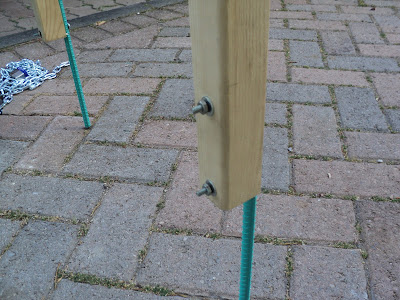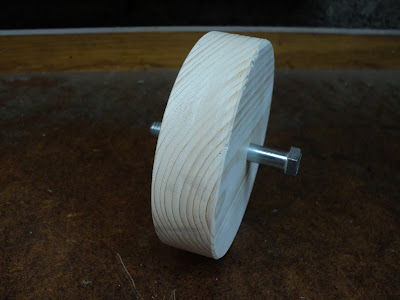It turns out that tealights are not a great choice for lighting a jack-o'-lantern. They don't last nearly as long as they ought to. Here's a view of one that I pulled out of a jack-o'-lantern after only about two hours. (The lights are rated for four hours.[1])
The wick got consumed completely long before the fuel ran out. Being out in the cool autumn air, and sitting on cold pumpkin flesh inside the pumpkin, the tealight's body couldn't warm up enough that the fuel could melt fast enough to keep feeding the wick with liquified fuel.
I still like the idea of using a tealight to light a jack-o'-lantern, though. Tealights are cheap; I got this package of 32 for $2.00 at the 'dollar' store.
So, I'll do a little experiment. I'll make a wooden holder for a tealight, so the light's metal cup will be insulated from the cool air and the cold pumpkin's flesh. I have a 2 1/2" diameter softwood off-cut from a lathe turning that should make a good holder. I bored a 1 1/2" diameter pocket in that to receive a tealight, like so.
I'll install that in my jack-o'-lantern and set it out by the back door to the workshop, where no one will see it and think that I'm trying to make a multi-night festivity out of Halloween, like the twelve days of Christmas or something. Here's a view of my experiment underway.
- - -
Well, so much for that experiment.
The tealight with the wooden insulator lasted over two hours, but met the same fate as an uninsulated tealight -- it consumed its wick long before it could exhaust its supply of fuel.
So there we are. The tiny flame of a tealight can't overcome the chilling effect of a low ambient temperature on its fuel supply, and liquifiy sufficient fuel to keep itself going.
Next year, I'll try using a dollar store votive candle as a jack-o'-lantern light, and see how that does.
* * *
Note:
[1] I checked out the 'four hours' rating under ideal conditions indoors, and four hours turned out to be a conservative figure. With a tealight perched on a scrap of softwood inside the workshop, the light burned for well over four hours. By about half way through that amount of time, the fuel inside the light's metal cup had liquified completely -- there was no possibility of the wick running out of fuel and consuming itself before the fuel supply was actually exhausted.
# # #
# # #


















































